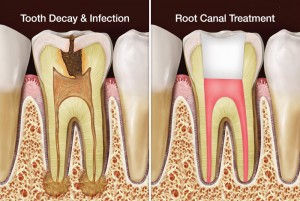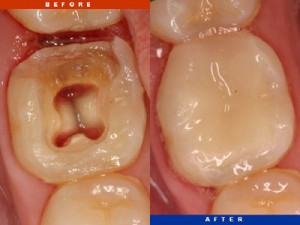 Root canal therapy refers to the process by which a dentist treats the inner aspects of a tooth, specifically that area inside a tooth that is occupied by its “pulp tissue.” Most people would probably refer to a tooth’s pulp tissue as its “nerve.”
Root canal therapy refers to the process by which a dentist treats the inner aspects of a tooth, specifically that area inside a tooth that is occupied by its “pulp tissue.” Most people would probably refer to a tooth’s pulp tissue as its “nerve.”
In a nutshell, the process of root canal treatment first removes (as thoroughly as possible) bacteria, nerve tissue, the organic debris left over from the breakdown of nerve tissue, and bacterial toxins from within the inner aspects of a tooth (the area originally occupied by the tooth’s nerve tissue). Each of these items can produce tissue irritants that can cause your body to activate an inflammation reaction. Most patients will notice that the tooth in question will be sensitive or painful whenever they drink or eat something extremely hot or cold.
 Once this space has been cleansed the second half of root canal treatment involves filling in and sealing up the interior of the tooth. This aspect of the treatment is an attempt to minimize the possibility that bacteria re-entering the canal. The seal also contains and encapsulates any debris that could not be fully removed during the cleaning aspect of the root canal treatment process so that it can’t leak out and trigger an inflammation reaction. It will take an examination by your dentist to determine if root canal treatment is indicated for your tooth. Not only must your dentist determine if the treatment can be an appropriate solution for your situation but also that the overall condition of the tooth in question warrants the time and expense involved. This is done by taking an x-ray and examination of the tooth in question.
Once this space has been cleansed the second half of root canal treatment involves filling in and sealing up the interior of the tooth. This aspect of the treatment is an attempt to minimize the possibility that bacteria re-entering the canal. The seal also contains and encapsulates any debris that could not be fully removed during the cleaning aspect of the root canal treatment process so that it can’t leak out and trigger an inflammation reaction. It will take an examination by your dentist to determine if root canal treatment is indicated for your tooth. Not only must your dentist determine if the treatment can be an appropriate solution for your situation but also that the overall condition of the tooth in question warrants the time and expense involved. This is done by taking an x-ray and examination of the tooth in question.
The total amount of appointment time that will be required for your root canal treatment can hinge on a number of factors. Some of these are:
- Different teeth have differing numbers of root canals, each of which need to be located, cleaned, and sealed. As an example, front teeth typically just have a single root canal while molars often have three or more canals.
- The tooth is usually done in one or two visits depending on the state of the tooth; infection or a complicated root system
- Until your dentist has had a chance to finish rebuilding your tooth it should be considered to be fragile.
- A dentist will use a dental crown as a means of improving the appearance of a tooth, restoring a broken tooth to its original shape, and/or strengthening a tooth.
Advantages:
- You save the natural tooth and keep the natural arch of the teeth intact.
- It is usually cheaper and easier to restore your own tooth.
- The tooth wills no experience pain when you drink or eat something that is hot and cold.
Disadvantages:
- Initially there may be some tenderness when pressure is applied to the tooth.
- It costs more than an extraction.
